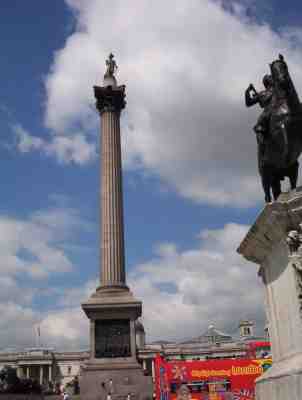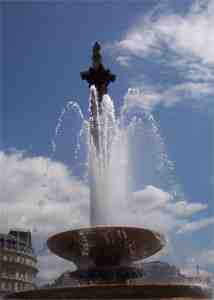
|
||
Nelsons Column Trafalgar Square London EnglandNelsons column is located literally in the heart of Trafalgar Square London. William Railton was commissioned to build it and the origional model is not exactly the same as the full size version. It took 3 years to put up. Lord Admiral Horaio Neslon is a great British naval hero. Nelson's Column is a memorial produced after his victory and unfortunate death at the battle of Trafalgar. 
History of Nelsons ColumnAfter Nelson's death, he became such a hero in the United Kingdom that the government decided to commemorate both the importance of the battle and the popularity of the victor. The Nelson Memorial Committee was founded in 1838 to raise money for a memorial to Nelson. They also invited people to design an appropriate monument. The architect William Railton won the commission later that year. William Railton's Original Model Railton's proposal and model had a gray marble base, but showed some details not featured in the finished monument. It had an additional flight of steps in front of the monument. Any visitor would have had to walk up this flight to reach its foot. The model is on display in The National Maritime Museum. It was loaned to the Museum in 1958 by a London steeplejack who had bought the model from a stonemason some years earlier. 
The Heart of Trafalgar SquareSuch a monument as Nelson's column needed a place to embrace it. The main commercial districts of the city of London are built around Trafalgar Square and Piccadilly Square. Between 1829 and 1843, John Nash designed London's Trafalgar Square. Around the sides of the square are the church of St Martin's in the fields and the National Gallery. The latter houses one of the world's richest collections of paintings. Nelson's column remains in Trafalgar Square to this day. The square is overrun daily by pigeons. It is a major tourist attraction in London. Although one can not see any specific detail of the statue, it still impresses visitors. It can be seen from a great distance. Also the streets of Whitehall and Charing Cross flow from it. The building of the monument began in 1840. It took three years to erect. Dominating Trafalgar Square, is the column that is over 180 feet high. Acanthus leaves, cast from British cannons decorate the top. At the base are four bronze relief panels cast from armaments captured from the French. These panels depict the four great victories of Admiral Nelson. In 1843, just before Nelson's statue was placed on the top of the column, 14 stonemasons held a dinner on the flat top of the supporting column. An 18-foot high statue of Nelson stands on top of the column. The four great lions at the base of the column seem to guard it. These were added later in 1868. They are made of bronze and designed by Edwin Landseer. The monument was at one point sold to an American by a Scottish con man. Admiral Horatio Nelson - History of a Hero of the British NavyBorn in 1758, he was made commander in chief of the British fleet in May 1803. This great man fought valiantly for his country many times and won many notable naval battles. This came at the personal cost of losing an arm and one eye. Admiral Horatio Nelson's last and most famous battle was the Battle of Trafalgar. Off the Spanish cape of Trafalgar, he defeated Napoleon and the French and Spanish fleets. Sadly, during it, on 21st of October 1805, he lost his life aboard H.M.S. Victory. The Battle of TrafalgarSailing on his flagship, Victory, Nelson went in search of the French. He first found the French fleet at Toulon, but they managed to slip away from him. Nelson chased the French to the West Indies and then back in to European waters. It was more than two years before Nelson was able to bring the French fleet to battle. News came that the enemy were near near Cape Trafalgar. Nelson set sail from St. Helen's on 15 September 1805 in Victory. He was accompanied by the Euryalus frigate. He aimed to to take command of the fleet at Cadiz. He was joined by a number of other ships on the way. As he drew near he sent Euryalus ahead to make sure on his arrival no salute should take place. By this means he hoped to keep the enemy ignorant of his reinforcement of the fleet. He stealthily joined with the fleet on the evening of September 28. The French and Spanish fleets left Cadiz. His fleet kept at a distance but were signaled about movements and gave stealthy chase. As he now knew their position the decision of when to engage has to be made. Many times he is said to have said "The 21st of October will be our day." On 21st of October 1805, Nelson wrote his will and a prayer by his own hand, before battle commenced. Noteworthy here was that no flags were visible on the enemy flag-ships. So, Nelson could only identify one, by it having four decks. He ordered Victory to sail for the bows of this. About 1/2 an hour before the enemy opened fire, Nelson ordered a famous signal to be telegraphed. "England expects that every man will do his duty." It was received by the fleet with enthusiasm. Union Jacks were hoisted. Some divisions also hoisted the Flag of St George. Nelson sailed to block the port of Cadiz as a potential escape route. So, his second in command was the first to take fire when the enemy opened up at 11.30. At 11.55 Victory came under fire. Many were killed. A shot went between Hardy and Nelson. They stopped immediately, looked each up and down supposing the other to be wounded. Afterward Nelson said he thought it was to warm for the battle to last long and complimented the courage of Victory's crew. The Death of Admiral NelsonIn the heat of battle and at close quarters to the enemy ship Redoutable, much of Victory's crew were injured or killed by musket fire. It was from this ship's mizen-top, at about 13.15, the fatal shot that hit Nelson came. Nelson was taken to the surgeon below deck. Here he lay and conversed for 2 hours. Hardy visited with him twice. First to enquire about his health and then to tell him that his brilliant victory was complete. Hardy returned to duty on deck. While he could speak Nelson repeated one line. "Thank God, I have done my duty." He was pronounced dead by the Surgeon at 16.30. He is fittingly entombed in a ship shaped sarcophagus in St Paul's Cathedral. |
||